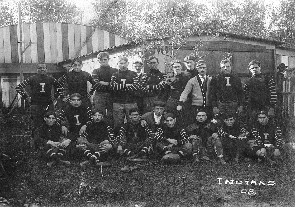 The 1908 Akron Indians. Baker is the first player in the back row, left side. Image via Wiki/Public
The 1908 Akron Indians. Baker is the first player in the back row, left side. Image via Wiki/Public
In the early 1900s, African Americans were not allowed to play in the National Football League. It was not until 1902 that Charles Follis broke the color barrier by becoming the first African American to play professional football in the United States with Shelby Athletic Club.
When Follis retired in 1906, there was a gap in the professional football space for Blacks. This space was later filled by Charles “Doc” Baker, who became the second Black professional football player while playing for Akron Indians, according to African American Registry.
Even though he had a short stint with Akron Indians, he was popular among his teammates who referred to him as Doc. He got that name because he once served as an aide to a physician. At Akron Indians, Baker played halfback from 1906 to 1908, and a final season in 1911. He is noted for his defensive play and ability to go on the offensive when the moment demanded. He played as if he was invincible to injuries.
Even when his opponents attacked him ruthlessly with others on top of him, he always shook off the experience with a smile. He was adored by both the fans and teammates of Akron Indians and described as one of their best halfbacks.
Baker is believed to have been brought up in an Akron children’s home and is thought to have died in the early 1920s. There is not much public information on how he lived his life after football.
Due to the degree of segregation in the United States, the African-American community turned their energies to creating their socio-economic institutions because of how the system was built to disadvantage them before World War I. This also included sports. The blacks sought to improve the number of black players in the national football and baseball leagues.
What helped was when the administrative structures were infused into the running of football clubs by entrepreneurs and sponsors. When entrepreneurs forced the system to embrace competition it eased the pressure on black players to push themselves to attract the eye of football clubs.
This is evident in the mad rush for good football players in the mid-1900s irrespective of race. This paradigm shift was at a time when race riots were prevalent in 1919 in Chicago and other parts of the United States.
The 1920s was tagged as the golden age of sport for many black players who made entry into the National Football League. That season saw the exhibition of African American talent on the pitch making a huge statement of their capability.
The argument made was that the reason black stars were not playing in the National Football League was that the game had been dominated by players from the rural South. The other concern also was that much was not being done to protect black players from attacks, gang tackling and maiming.